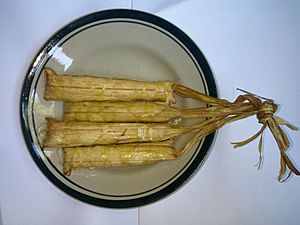Kelupis facts for kids

Kelupis in a licuala grandis leaf wrapper.
|
|
| Type | Snack (Kuih) |
|---|---|
| Place of origin | |
| Region or state | |
| Created by | Bruneian Malay , Lun Bawang/Lundayeh, Bisaya and Bajau |
| Main ingredients | Glutinous rice flour, palm sugar |
Kelupis is a traditional and delicious snack from Southeast Asia! It's a special type of kuih (which means a snack or dessert) that's very popular in the country of Brunei. You can also find it in the Malaysian states of Sabah and Sarawak. Kelupis is made from glutinous rice and often wrapped in unique leaves.
Contents
What is Kelupis?
Kelupis literally means 'glutinous rice rolls' in English. It's a small, often triangle-shaped snack. The main ingredient is glutinous rice, which is a type of sticky rice. This rice is cooked until it becomes soft and chewy.
How is Kelupis Made?
Making Kelupis is a careful process. First, the glutinous rice is cooked, sometimes with coconut milk for extra flavor. Then, it's often mixed with palm sugar to make it sweet. The mixture is then shaped into small rolls or triangles.
The Special Wrapper
A very cool part of Kelupis is its wrapper! It's traditionally wrapped in the leaves of the licuala grandis plant. These leaves give the Kelupis a special smell and taste. Wrapping it in leaves also helps to keep it fresh.
Where Does Kelupis Come From?
Kelupis is a very important snack for several groups of people. It's a traditional food for the Bruneian Malay people in Brunei. It's also popular with the Bisaya people. The Lun Bawang/Lundayeh and Bajau people also enjoy making and eating Kelupis. These groups often share similar traditions and foods.
When is Kelupis Eaten?
Kelupis is a versatile snack. People enjoy it any time of day. It's often served during special events and celebrations. You might see it at weddings or other important gatherings. It's a symbol of hospitality and tradition in these cultures.

